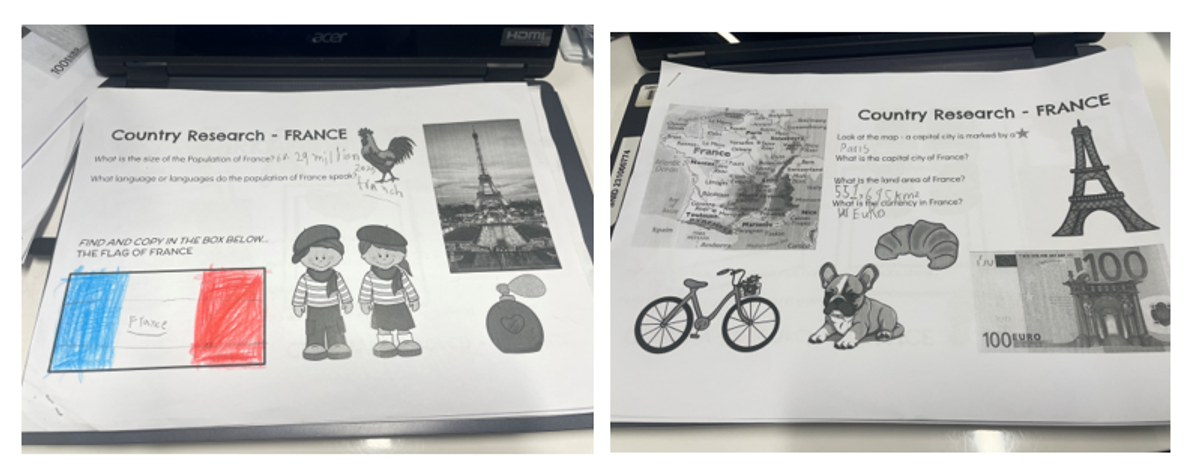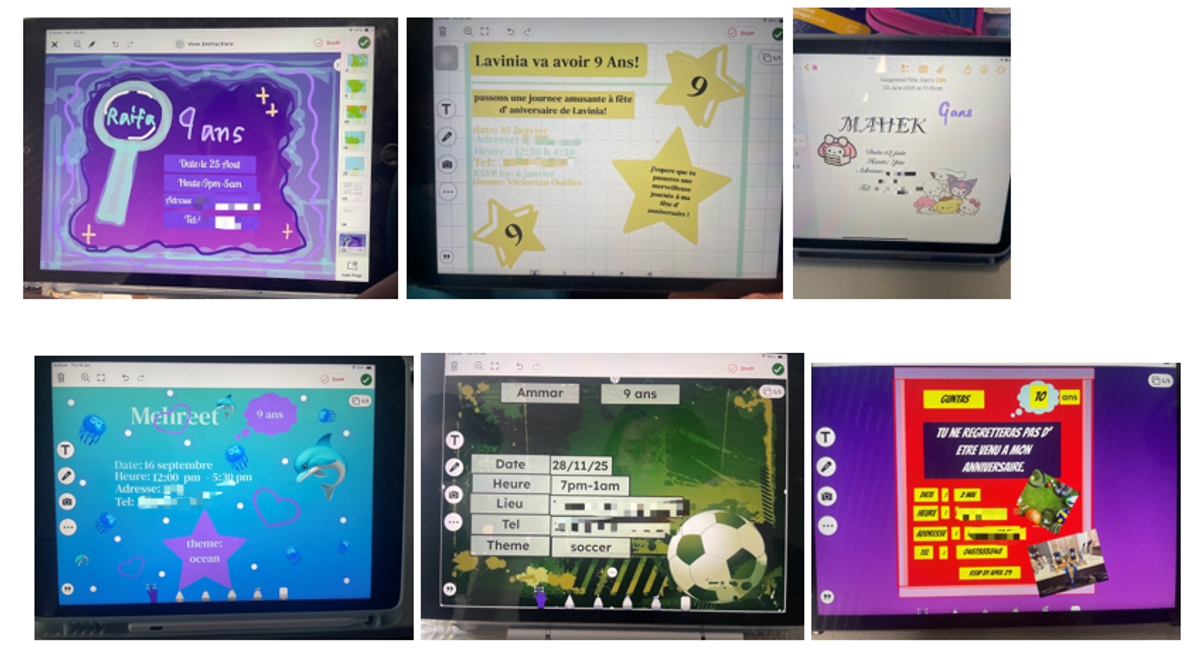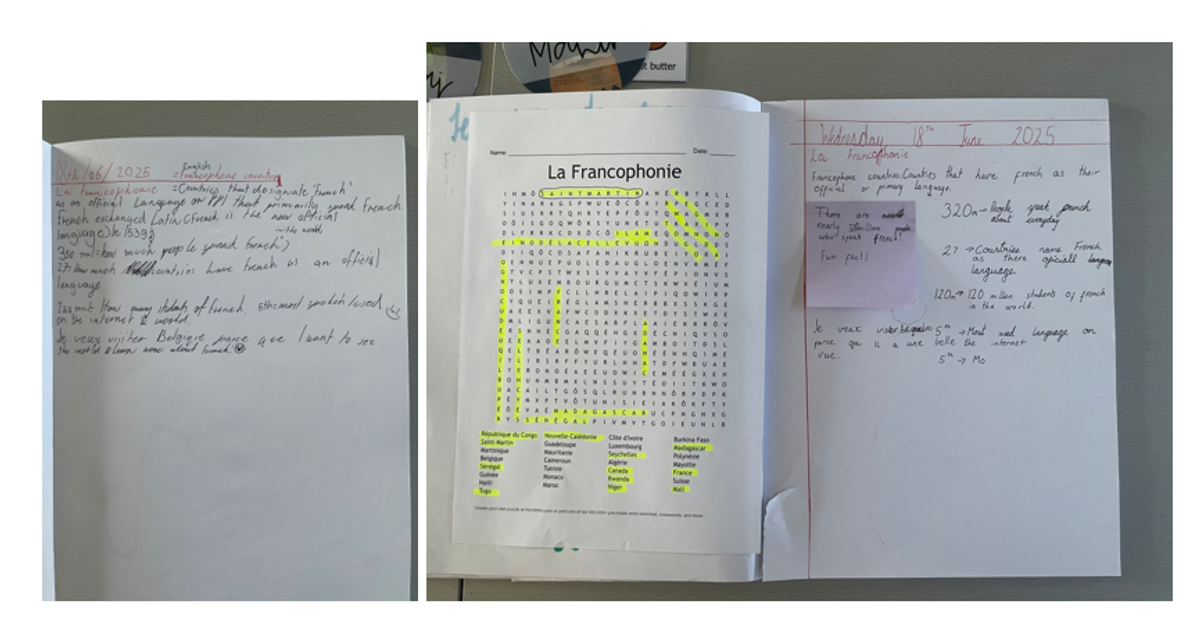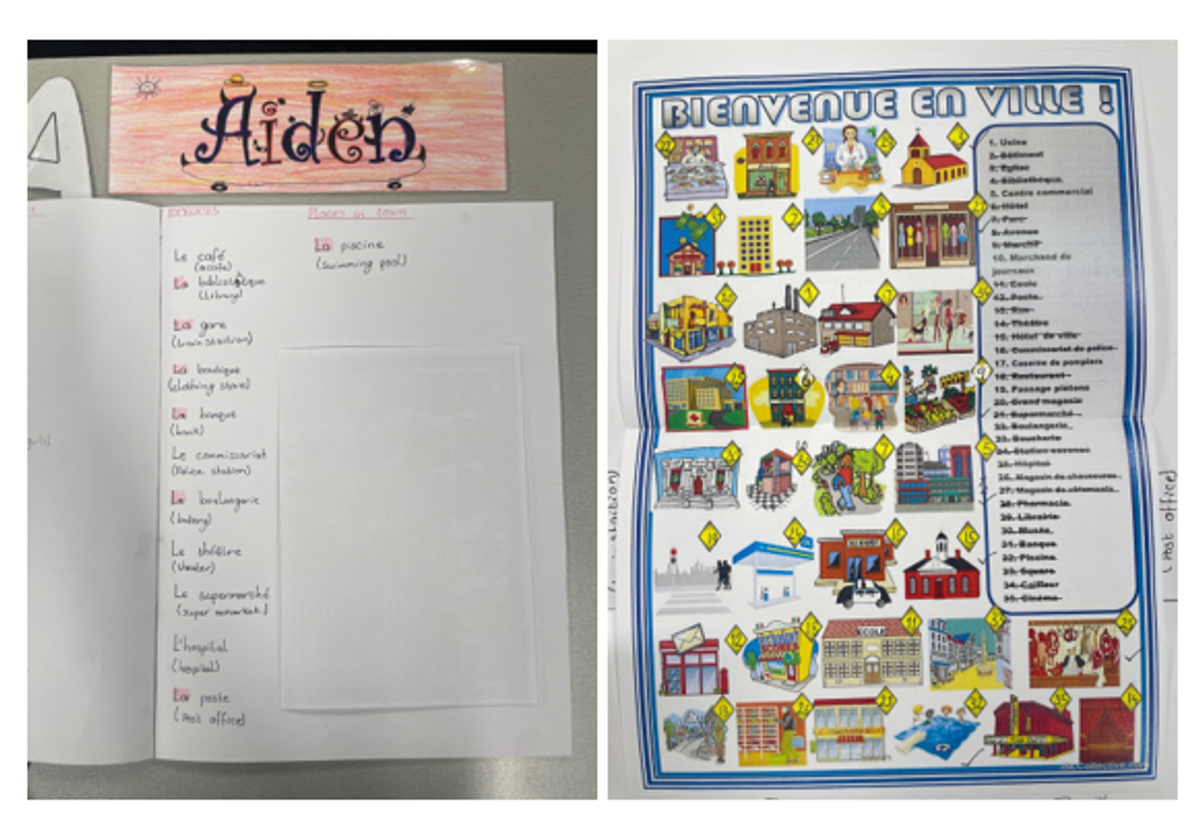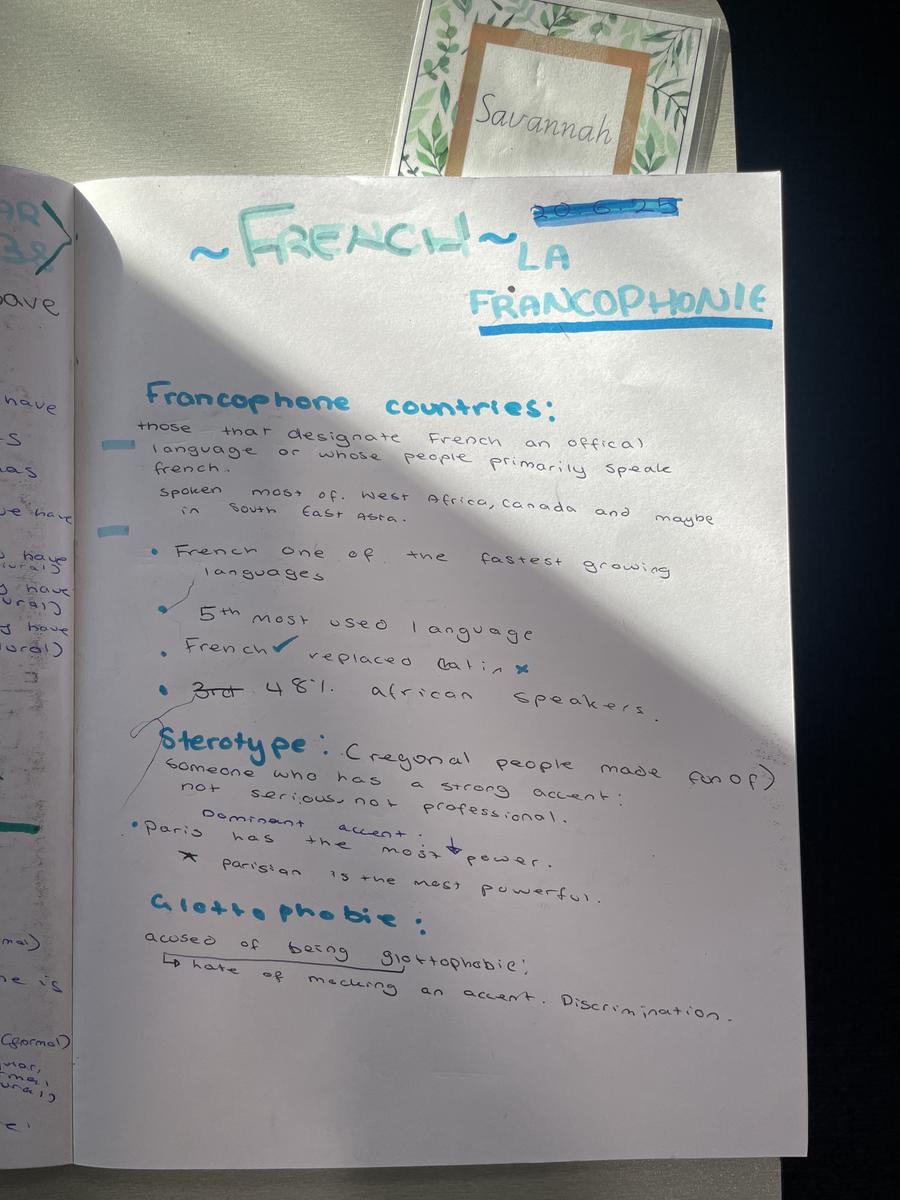French News
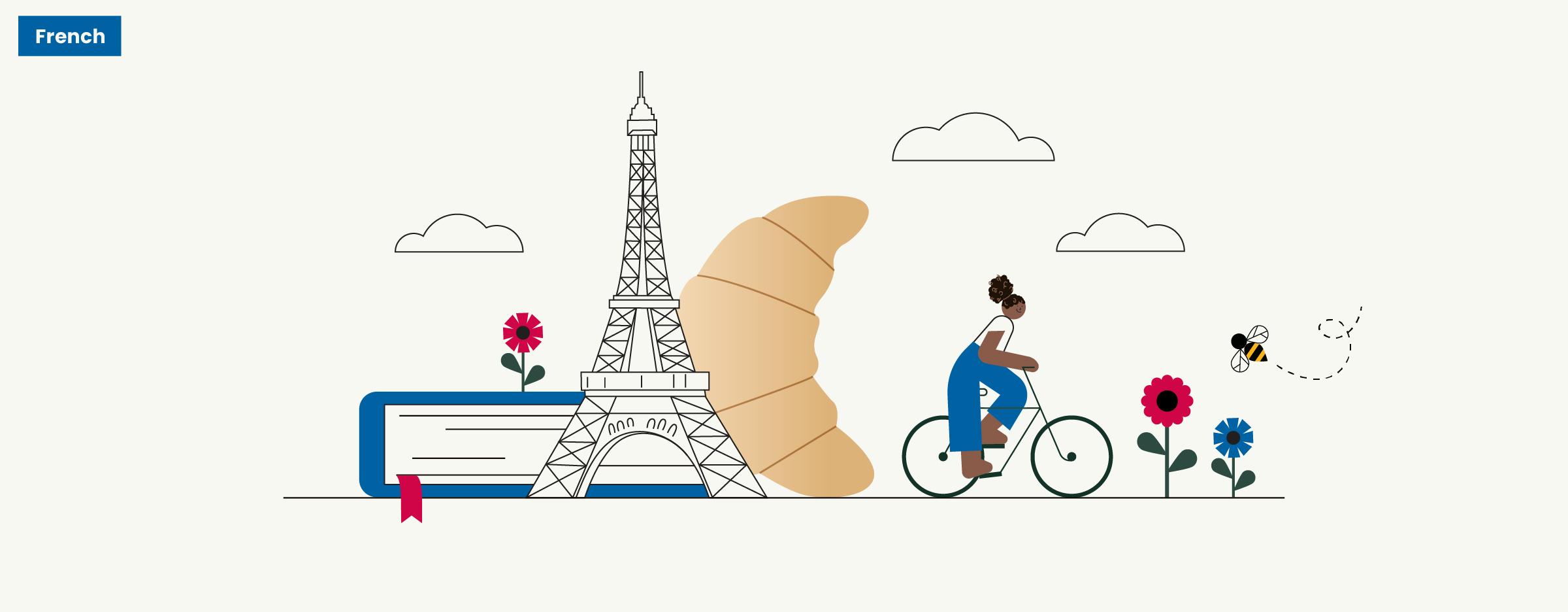
French Semester 1 Overview
Grade PREP
In Term 1, Prep students explored greetings, self-introduction, classroom instructions, numbers, the alphabet, colours, and days of the week in French. They learnt bonjour (hello) and salut (hi), using them with classmates and tracing the words to support recognition. Using je m’appelle, they introduced their name, reinforced by a self-portrait and word tracing. French classroom instructions were introduced, and students practised listening to, and following them consistently throughout the semester. Students learnt to count from one to five, using finger gestures and completing a tracing task to help spell the words. Letters A to J were introduced, with students practising saying the sounds and identifying the letters when prompted. They explored colours by recognising the spelling of each colour through a colour wheel worksheet. To finish the term, students learnt the days of the week, practised saying them aloud and putting them in order through a cut-and-paste activity. Across all topics, students engaged in games, movement, and creative tasks to build confidence using simple French words and phrases.
In Term 2, students continued building their French skills through speaking, reading, writing, and listening to simple vocabulary. They revised the days of the week and extended number knowledge up to 10, focusing on recognising the sounds and letters that make up each word. Farm animals were introduced in short sentences, students learnt to use C’est (This is) to make a statement. Family members were also introduced through speaking tasks and drawings of their own families. Students extended their alphabet knowledge to Z, and they revisited colours which both enhanced their ability to read French words. Students also learnt polite phrases such as merci (thank you) and began using them confidently in classroom routines. Learning was supported through songs, speaking, and creative activities that made French fun and meaningful.
Grade 1
In Term 1, Grade 1 students explored greetings, self-introduction, classroom instructions, numbers, the alphabet, colours, and the months of the year in French. They practised greetings such as bonjour (hello), salut (hi), and au revoir (bye) through various activities, including tracing, colouring, and speaking, with songs supporting pronunciation. Using Comment tu t’appelles? (What is your name) and Ça va? (How are you), students practised asking and answering simple questions with each other. Students learnt classroom instructions and demonstrated their understanding through interactive tasks. Numbers from 11 to 20 were introduced with activities to help recognition and pronunciation. Students revisited the French alphabet through listening to, pronouncing and tracing the letters, they then expanded their colour vocabulary. The months of the year were introduced for the first time. Students practised repeating the months and recognising the words for each month. Throughout the term, songs and engaging activities enhanced the learning experience.
In Term 2, students expanded their French skills through topics including farm animals, emotions, classroom objects, polite phrases, numbers, and months of the year. They learnt animal names and created statements using the sentence starter C’est (This is) and colour words from previous knowledge. Students learnt vocabulary for classroom objects and emotions, using the sentence starters Il y a (There is) and Je suis (I am) to create simple sentences through writing and speaking activities. Polite expressions were introduced, and students began using them in everyday classroom routines. Vocabulary like numbers 1–20 and the months of the year was reinforced through a variety of counting, listening and writing exercises. Across all topics, songs and interactive tasks kept learning fun and engaging.
Grade 2
In Term 1, Grade 2 students focused on building their confidence with basic French vocabulary and expressions. They learnt how to greet others, use polite phrases such as merci (thank you) and s’il vous plaît (please), and follow common classroom instructions in French. They practised saying these phrases aloud and responding to them when used by their teacher and classmates during daily routines. Students also reviewed and strengthened their knowledge of the days of the week and months of the year. They practised listing them in order, saying them aloud, and writing short sentences to talk about their favourite day and the month of their birthday. Their number knowledge was extended to 30 through counting games, songs, and worksheet activities. Finally, students were introduced to vocabulary for emotions. They learnt how to express their feeling and practised using the correct gender form when describing their emotions in simple spoken and written sentences.
In Term 2, students expanded their vocabulary and sentence-building skills through a variety of topics. They learnt the names of family members in French and practised using sentence starters to write complete sentences about activities they enjoy doing with different family members. Students were also introduced to the names of wild animals. They practised labelling animals, writing simple sentences about their favourites, and conducted basic research in English on an animal of their choice to support their learning. In maths-related language work, they extended their number knowledge to 50, with a focus on listening carefully and identifying spoken numbers in French. Culturally, students explored the idea of multiculturalism in Australia and began learning more about France by working on an "All About France" booklet, helping them connect language learning with real-world places and cultures.
Grade 3
In Term 1, Grade 3 students learnt to use “the” and “a” correctly, paying close attention to the gender and number of nouns to refer to specific or non-specific things. They also learnt how to say “my” in French using mon, ma, and mes, and practised writing complete sentences to describe family members while ensuring correct gender agreement in adjectives. As part of their vocabulary development, students learnt the names of days and months and practised speaking by asking and answering questions about dates. They revisited the days of the week through the story La chenille qui fait des trous, writing sentences about what the hungry caterpillar ate each day. Additionally, students learnt common weather phrases, conducted simple weather research, and described weather conditions in French. From a cultural perspective, students reflected on their own language and cultural backgrounds by creating a language portrait, deepening their understanding of their identity and language-learning journey.
In Term 2, students shifted their focus to speaking and pronunciation. They learnt to recognise and say common vowel combinations and word endings, even when the words were new to them. They also began learning to match French verb endings with the correct subject pronouns, which we call “conjugation”, helping them form simple sentences more accurately. Students revisited the topic of weather and wrote a short paragraph about the weather in a country of their choice. They also learnt vocabulary for sports and practised asking and answering questions about favourite sports in French. As a class, they gathered this information and created a sports data chart, linking their French learning with maths. Students continued practicing everyday conversation skills through simple dialogues. Culturally, they explored French-speaking countries, created their own birthday invitations in French, and learnt about the influence of the French language and culture in Australia.
Grade 4
In Term 1, Grade 4 students started by learning how to tell 24-hour time in French. They practised saying, listening to, reading, and writing the time using the hour, half-hour, and minutes. Alongside this, students learnt vocabulary for school subjects, and they combined the days of the week, times, and school subjects to describe their weekly schedule, helping them use their new language in meaningful ways. Students were also introduced to the imperative form, a way of giving instructions, through an engaging activity based on a crème brûlée recipe. They learnt how to identify verbs in the imperative mood and understood how instructions are written differently from regular statements. Culturally, students explored the world of French bread. They looked at different types of traditional breads, such as baguettes and brioches, and designed their own bakery menus.
In Term 2, students began by learning food-related vocabulary and were introduced to a new type of article in French, the partitive article, which is used to talk about uncountable items such as water, milk, and bread. They practised writing full sentences about what they eat and drink for each meal. They also explored a wide range of emotion vocabulary, including both adjectives and related nouns. They practised using these emotion words to form complete responses in French to short scenario prompts. Students were introduced to -ER verb conjugation — a key part of French grammar. They learnt how to match these verb endings with different subject pronouns to build correct sentences. In number work, students extended their knowledge to numbers up to 80. They focused on listening skills and practised hearing and writing phone numbers in French, which are usually said in pairs. Culturally, students read a French poem, where they practised their speaking and presentation skills. They also researched a Francophone country of their choice, discovering its rich culture.
Grade 5
In Term 1, Grade 5 students explored a variety of topics, including common vocabulary and phrases, essential grammar, and aspects of French culture. They began the term by practising understanding and saying classroom commands, which supported their learning throughout the semester. They learnt to conjugate regular -ER verbs through reading and conjugating practice. Students explored prepositions to describe object placement and progressed to giving directions. They created and role-played a dialogue asking and answering how to get to various locations. Students also practised adjectives by describing family members, ensuring agreement in gender and number. Additionally, they shared their favourite activities and daily routines. As part of a literature project, students were introduced to Blanche-Neige (Snow white), they then wrote alternative endings and presented them in French. To conclude the term, students learnt how to order at a restaurant using correct expressions and sentence structures and acted out restaurant scenes to enhance their speaking skills.
In Term 2, the emphasis shifted to French pronunciation, while continuing to build on grammar knowledge. Students read aloud poems to build fluency, and they were introduced letter combination sounds through reading and listening exercises. They learnt to form negative sentences through whiteboard exercises and worksheet activities. Conjugation of -RE verbs was introduced, along with creating close-ended questions by restructuring sentence elements. Using these skills, they designed and conducted class surveys in French, which helped improve their confidence and fluency in speaking the language. Students also tackled the irregular verbs avoir (to have) and être (to be), practicing their conjugations both orally and in writing. To conclude the term, they revisited prepositions and directions, worked in groups to follow and give roadmap instructions, and created a model town in French.
Grade 6
In Term 1, Grade 6 students showed notable growth in French, building on foundational skills to communicate effectively and confidently. They enhanced their understanding of classroom instructions and moved to a more advanced use of -ER verbs, applying pronoun-verb agreement accurately in context. Their understanding of prepositions and directions developed from basic descriptions to giving and following detailed instructions, including the use of cardinal directions. Students expanded their descriptive abilities by using adjectives to talk about family members, applying proper agreement in gender and number. They further progressed by sharing personal preferences and describing daily routines with greater fluency. Through the study of Blanche-Neige (Snow White), they created alternative endings to the story, demonstrating creative thinking and improved writing in French. The term concluded with students applying conversational skills in a simulated restaurant setting, using more complex expressions and structures in role-play activities.
In Term 2, students started by presenting poems aloud to improve fluency and articulation. They then advanced their grammar by constructing and responding to negative sentences and practised these in pair activities. The introduction of -RE verbs and irregular verbs like avoir (to have) and être (to be) challenged students to apply new conjugation patterns both orally and in writing. They also learnt to form questions by restructuring sentences, applying these skills in peer-led surveys. Their pronunciation skills deepened through these targeted reading and conversational tasks. They ended the term by comparing different French-speaking countries and completed a culminating project that showcased their research and understanding of Francophone cultures.
